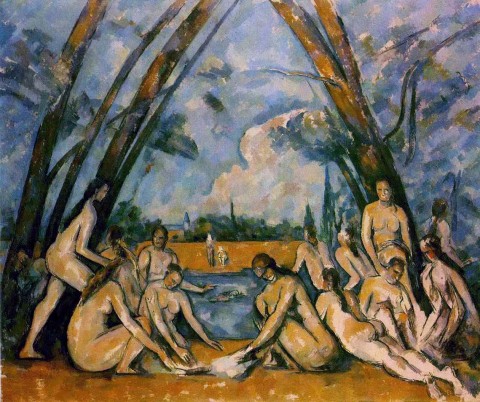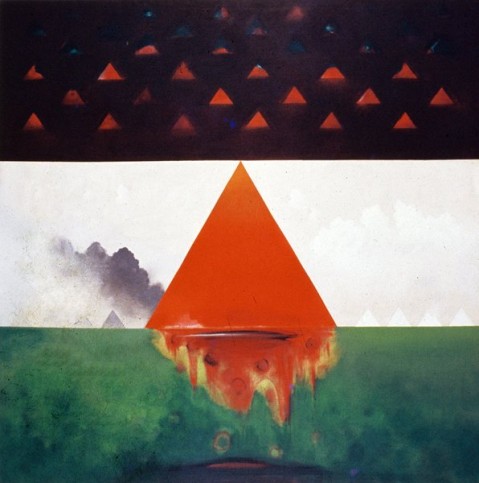

The Malaysian National Art Gallery – Balai Seni Lukis Negara, which might otherwise be called a museum of modern art, currently hosts a retrospective of one of Malaysia’s most esteemed artists – Syed Ahmad Jamal; celebrating his eightieth birthday, and almost sixty years devoted to art and art criticism.
Born in Muar, Johor in 1929, Syed Ahmad Jamal, like many Malaysian artists of his generation, studied arts in England. Syed Ahmad Jamal studied architecture in Birmingham, England (1950), and later painting in the renowned Chelsea College of Art, London, notable for having Leonora Carrington and Edward Burra as alumni. His resume extends from teaching art, art teacher training, through to heading up the National Museum of Art (now National Art Gallery), as director (1981 – 1993). In 1995, Dato Syed Ahmad Jamal was honoured with the National Art Award and has become known as the Malaysian National Art Laureate.
Pelukis, the current Syed Ahmad Jamal retrospective, affords the National Art Gallery visitor with an uncluttered view of the artist’s professional and individual progression. The exhibition reveals paintings from the artist’s cubist and expressionist inspired 1950s works, through his more abstract phase in the late 1960s, and into the 1970s, right up unto the more spiritual, yet still expressionistic works in the 2000s.The artist’s work spans a time from Battersea Park II (1956) toM50 (2007).
This major retrospective does what retrospectives tend to do best – give the exhibition/gallery visitor a chance to witness, for themselves, the artists’ progression/growth into his craft. It allows the caller to observe the roads not taken, and the paths followed with the ‘becoming’ of a painter such as Syed Ahmad Jamal.
From the painter’s early works, executed during the 1950s, the links to both Cubism and Abstract Expressionism are self-evident. In Battersea Park II (1956) the colours and forms of German Expressionist and Blue Rider (Der Blaue Reiter) founder Franz Marc are quite clear. Nipah Palms (1957), Mani Laut (Sea Bathers -1957) Padi Field Morning and Padi Field Night (1958), emerge from a fondness for the later cubist works, which slip quite easily into Abstract Expressionism, reminiscent of that father of Cubism Georges Braque.
Forty is a reasonable age, in some it is the age where they start to settle down, lose the anger of youth and approach life from a more considered, perhaps even philosophical viewpoint. It is a time when we stop searching for who we are. Instead, we begin to become who, and what, we are. We become aware of the differences between what we know about ourselves, and what others observe, what we present and what is hidden, as revealed in the Johari Window. We begin the true process of what Jung called ‘individuation’, or making ‘whole’. What we can observe in Syed Ahmad Jamal’s work from the age of forty onward, is a predilection for images of triangles and a growing visual, spiritual, symbolism.A few years later, during the 1960s, Syed Ahmad Jamal is seen experimenting with more obvious forms of abstraction, edging out of Cubism with the neo-Expressionistic Hararpan – Hope(1962), until in 1967 he produces Pfft and in 1968 Windows in the Sky, then in 1970 – One Fine Day. To some extent bothWindows in the Sky and One Fine Day are painterly breakthroughs leading the artist into fresh mode of expression, ground zero for the next thirty plus years of the artist’s image making. By the time Syed Ahmad Jamal has completed One Fine Day, the artist is forty years old.

Gunung Ledang, Tanjung Kupang, 1978
A Malay myth informs that the mountain – Gunung Ledang, previously known as Mount Ophir, in Johor, was where a beautiful princess (puteri) lived. Having rejected many suitors she eventually married Nakhoda Ragam, only for the marriage to end in disaster, the death of Nakhoda and the return of the princess to her mountain – Gunung Ledang.Gunung Ledang(Legendary Mountain [Mount Ophir] 1978) may not be the first use of the triangle in the works of Syed Ahmad Jamal, but, without doubt, it is the most significant. PerhapsCatch a Falling Star (1967) is the first. In Gunung Ledang, using a triangle device, the artist presents his viewer with what may be described as a mountain, hence the Gunung of the title. Yet the triangle stretches from the base of the canvas through to the last third. Bars construct the triangle, which may be perceived stretching into the perspectival distance, representing a ladder.The ‘window’ device from ‘Windows in the Sky’ is now green. At the top of the canvas small green triangles ‘float’. This is one of a series of works, which the artist has painted about his birthplace, the myths and legends pertaining to there, while maintaining the depth of symbolism within the artist’s expressionism.
The triangle from this point on, in Syed Ahmad Jamal’s painting, becomes a leitmotif, a recurring theme throughout his work.Symbolically, of course, the triangle may come to represent any number of things. Visually the triangle may depict stability, power, strength, inverted may denote dynamism. The triangle is the simplest figure to which all polygons may be reduced, and, for some, a representation of harmony because of that.
The artist’s use of the triangle may be an allusion to the Islamic symbol of consciousness incorporating the ‘knower’, the ‘act of knowing’ and the ‘known’. Further speculation may arrive at the triangle as ‘Taqwa’ (God consciousness), Ramadan (fasting) and Qur’an (guidance), the vital trilogy to lead a spiritually healthy and rewarding Muslim life. On the other hand, it may simply be, as others have noted before me, an image etched into the artist’s mind, forever forming part of his consciousness, growing up, as the artist did, under the shadow of the mystical mountain.

Paul Cezanne, The Bathers, 1906
Of course, there is artistic precedence for overt use of the triangle in painting. From the works of Kandinsky (Composition IV, 1911), Kazimir Malevich (Suprematism with Blue Triangle And Black Square, 1915), Paul Klee (Ad Parnassum, 1932) the triangle is prominent. To some extent, this is also true of the father of them all – Paul Cezzane; when he demonstrates the harmony of the triangle with Large Bathers (1899-1906), with trees and ground arranged to form a triangle, in which the bathers sit.
It seems poignant that the triangle should appear, and keep reappearing throughout the body of Syed Ahmad Jamal’s work from his own middle age, in the late 1970s, until the present. As life slips from youth, into older age, spirituality plays an increasingly larger role in life.
Endau Rompin (1985) (one of Malaysia’s national parks, in Johor -the artist’s birth state) features a triangle of foliage with a rainbow highlighting one of the triangle’s sides, another is delineated by what appears to be rain, the third is marked by a river – the River Endau of the name.
Sirih Pinang (Penang’s betel leaf) (1986) comprises of four triangles, meeting at the canvas centre. It would be mischievous to try to explain the triangles as representative of the four elements, though without too larger stretch of the viewer’s imagination earth, water, fire and air could be discerned. Art Nouveau betel leaves tumble in the foreground while the sky is punctuated by small variants of the triangle.

Soal Palestin (The Palestinian Issue), 1983
There are many more, but I should like to leave you considering this one last painting by Syed Ahmad Jamal – M50 (2007). M50as its name denotes, is a celebration of Malaysia in its fiftieth year. Unlike other paintings M50 has more of a Miro feel to it.There are two triangles, neither too dominant in the picture, surrounded by the apparatus of technology and prominent symbols – a number 1, question marks and a fragment of the British Union Jack (flag). Has the triangle of harmony, strength, God-consciousness finally been eclipsed by modernity. Is the triangle mountain, and its legends, being overwhelmed by man’s technology. I will leave that for you to decipher.In a similar modePalestin is dominated by a central red triangle, the canvas a tricolour of black, white in the centre and green at the bottom. In the black third are red triangle shapes. Mercu Wawasan (1997) although dominated by the concept of the Petronas Towers, also reveals triangles, one bottom centre canvas stretching to the bridge linking the two towers, while another reaches from top right canvas down to one third of the distance from bottom left to bottom right. Semangat Ledang (1999) has as its centrepiece a triangle, though partially obscured with flashes of yellow and red light. The tip of the larger triangle is revealed out of ‘cloud’ while a burst of white triangular light is emitted from the large triangle’s center.
There are many more, but I should like to leave you considering this one last painting by Syed Ahmad Jamal – M50 (2007). M50as its name denotes, is a celebration of Malaysia in its fiftieth year. Unlike other paintings M50 has more of a Miro feel to it.There are two triangles, neither too dominant in the picture, surrounded by the apparatus of technology and prominent symbols – a number 1, question marks and a fragment of the British Union Jack (flag). Has the triangle of harmony, strength, God-consciousness finally been eclipsed by modernity? Is the triangle mountain, and its legends, being overwhelmed by man’s technology? I will leave that for you to decipher.
Pelukis, a retrospective of the work of Syed Ahmad Jamal is on at the National Art Gallery, from 6th October 2009 to the 31stJanuary 2010, Gallery 1A.
~
(YM)
Sorry, the comment form is closed at this time.
S.A.J…freemason?
Simon thank you for taking the time and trouble to upload this and place titles under the pics. Er its Battersea Park II, as in the place that once existed in London, rather than, as you have titled – Battered sea park II.
Battersea Park was a ‘fun park’ pretty much like America’s Coney Island.